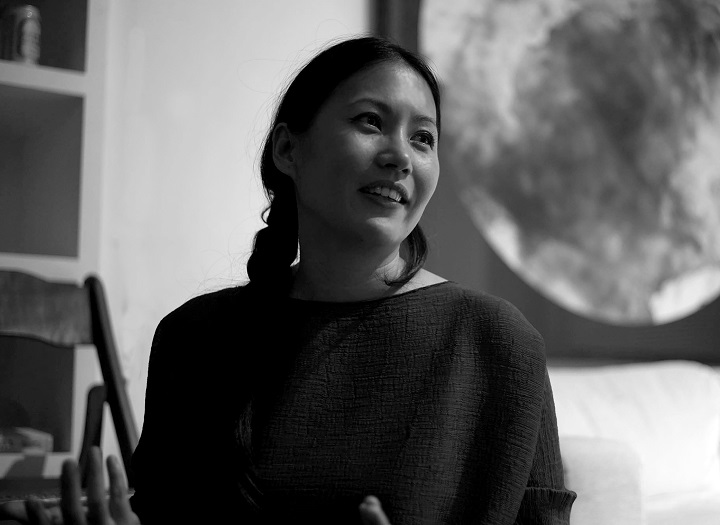Multi-medium artist Charwei Tsai has been busy at work in her Taipei studio over the past months. Recently, she completed a video work commissioned by the Green Island Human Rights Art Festival, while her works on paper series continues her exploration of organic material and the human experience within an ecological preoccupation, a constant in her practice. Charwei Tsai is one of the commissioned artist for public works at Art Dubai, selected by curator Nataša Petrešin-Bachelez.
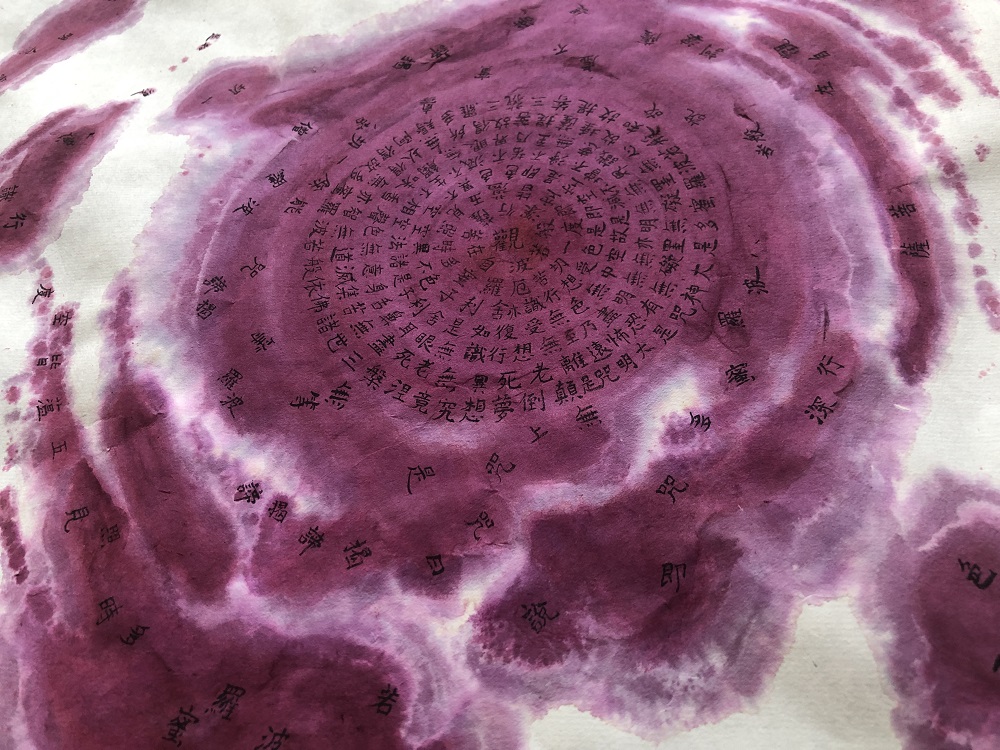
We Came Whirling Out of Nothingness (work in progress), 2020, plant based dye, watercolour & ink on rice paper, 90 x 90 cm. Photo courtesy of the artist.
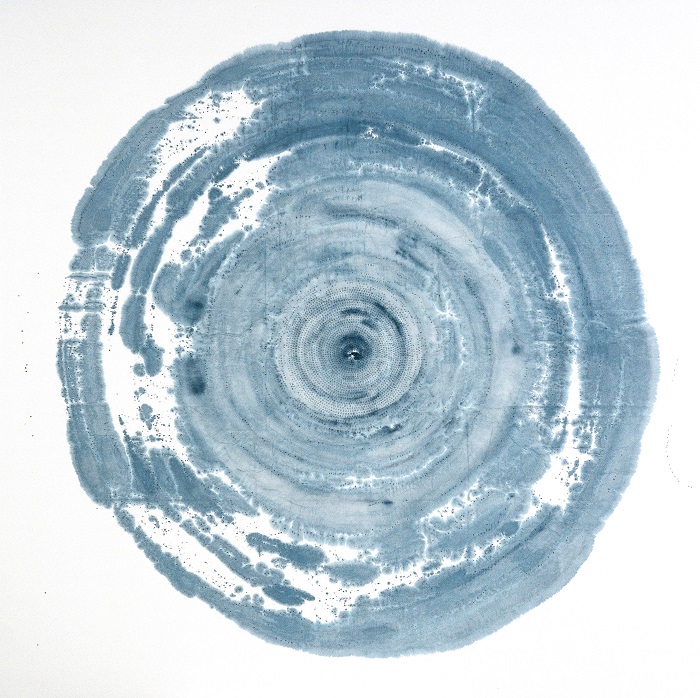
We Came Whirling Out of Nothingness III-VI, 2015, indigo & ink on rice paper, 214 x 214 cm. Collection of Winsing Arts Foundation. Photo courtesy of the artist.

We Came Whirling Out of Nothingness III-VI (detail), 2015, indigo & ink on rice paper, 214 x 214 cm. Collection of Winsing Arts Foundation. Photo courtesy of the artist.
Charwei Tsai discusses her practice, her recent projects, as well as the changes and shifts present in her work since March.
Art Dubai (AD): Can you tell us what you’ve been up to in the past few months; can you talk us through some of the projects you have been working on?
Charwei Tsai (CT): I am in the midst of preparing a series of new works inspired by a few pilgrimages that I took over the last two years. This body of work was for solo exhibitions at four very interesting spaces: a medieval monastery turned cultural ministry in Toulouse, a philosopher’s library in Los Angeles, a newly conceived space of a gallery in Jakarta, and a private art foundation in conjunction with the national opera house in Taiwan. All of the exhibitions have been postponed due to the pandemic, however, this gives me a lot more time to experiment and go deeper into each subject.
For example, for one of the projects, I have been working with the support of a curator Alia Swastika with a young weaver in Sumba, an island in Java, to create a series of handwoven textiles from local materials. Since this is her, as well as my first project of its kind, the process of communication from sourcing the cotton to hand spin the thread, to deciding on the type of dye made from local plants, to tying the pattern, to dying the thread, then finally weaving the textile required much more time than we had anticipated.
Now we are able to go slower to work out all the details and to keep refining the work. Not traveling and slowing down turned out to be the most beneficial factors for my work during this difficult period.
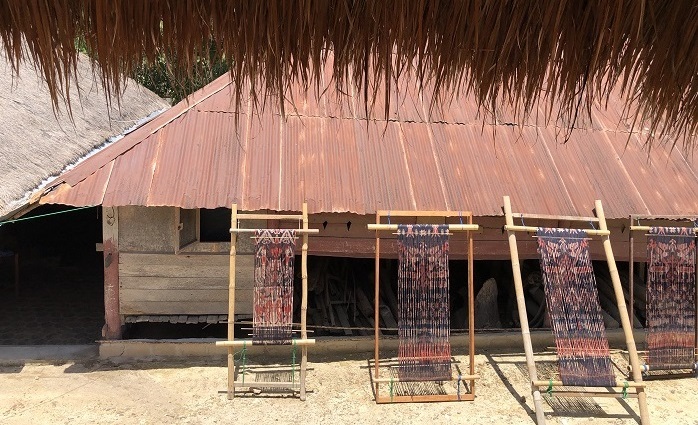
Site visit in Sumba, Indonesia, February, 2020. Photo courtesy of the artist.
In addition to these exhibitions, I have recently completed a new video work, Numbers (2020), for the Human Rights Art Festival in Green Island in Taiwan. It takes place at a former prison complex on Green Island where political prisoners who were mostly intellectuals and activists were kept during martial law from 1949 to 1987. This work is a reflection on how human lives and values are reduced to numbers under oppressive regimes.
Charwei Tsai, Numbers (short version), 2020, video with colour & sound, 6 min 34 sec. Commissioned by Green Island Human Rights Art Festival. Courtesy of the artist.
The work features the voice of Yang Tsui, granddaughter of writer Yang Kui who was a political victim imprisoned on Green Island from 1949 to 1962.
AD: Have you seen a shift in your practice as a result of the current global situation? For example in terms of themes explored, media used, methodologies applied or ways of connecting works?
Charwei Tsai (CT): Many changes in the way I work happened immediately and instinctively since the pandemic hit a few months ago. I started to crave working with my hands more and with more natural materials. For example, I have been experimenting painting with natural pigments from minerals and with plant-based dye for the first time. It is a completely different way of working because the natural materials are very sensitive to the changes in the environment and it takes many trials to gain control. For example, if I leave the windows open for a night, the pigments would settle on the paper differently than if the windows were closed. Though the process of working with natural materials takes much longer and it is less predictable, there are also many added layers of textures to the final works.
I also enjoyed tracing back in history to find that the same pigments such as those extracted from malachite were used in paintings since the ancient times in Egypt, Greece, India, China, and Central Asia. These colors are still vibrantly preserved in caves or on scrolls today. In addition to the paintings, I started to work with clay as well, some of which are made locally with soil from Taiwan. I am learning that the more raw the materials are, the less waste I produce, and the more grounded and connected to the environment I become.
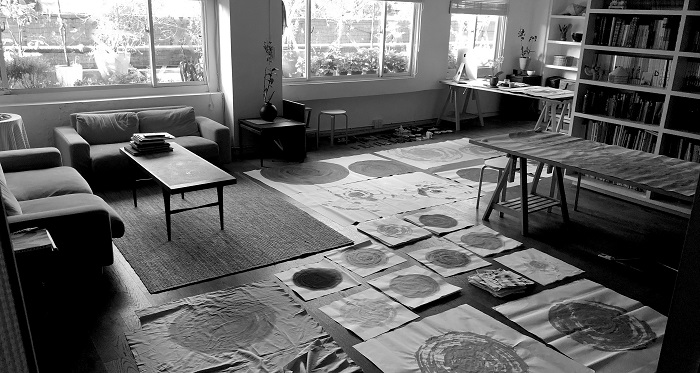
Artist’s studio in Taipei, August, 2020. Photo courtesy of the artist.
AD: You work with a range of mediums, one of them being video, and with the influx of dissemination of art digitally and online after global lockdowns, has this played a role in your framing of upcoming video works — in how you choose to present them across an increased/decreased number or different/new platforms or a change in the works themselves, for example?
Charwei Tsai (CT): It is about striking a balance between finding the most suitable context to present the work and making it accessible to all viewers even those who do not usually visit museums whether during the pandemic or not. In the context of my work, there are some videos like Sky Mantra (2009) where I don’t give full access online. In this twenty minute long video capturing a durational performance where I am writing on a mirror reflecting the changes in the sky, it does take a longer period of viewing time and a larger screen to fully appreciate the subtlety of the movement of the clouds and the changes in the light.
On the other hand, the series of videos where I filmed people living under harsh circumstances due to environmental, political, and economical shifts are intended to be more accessible in order to raise awareness on the implicit political and social issues. These videos include songs sung by earthquake victims in Nepal, women asylum seekers in the UK, and migrant workers in the harbor of Taiwan.
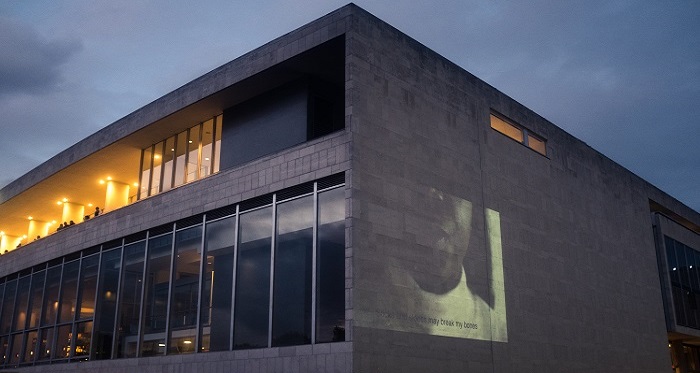
In collaboration with Tsering Tashi Gyalthang, Hear Her Singing, 2017, video projection on the wall of Royal Festival Hall, London, UK. Commissioned by Hayward Gallery, Southbank Centre, London, UK. Photo by Amas Amat Amo.
To view more of Charwei’s work, click here.
Charwei Tsai
Charwei Tsai’s practice is spurred by highly personal yet universal concerns. Geographical, social, and spiritual motifs inform a body of work, which encourages viewer participation outside the confines of complacent contemplation. Preoccupied with the human‐nature relationship, Tsai meditates on the complexities among cultural beliefs, spirituality, and transience.
Tsai has had solo exhibitions and projects at international institutions including: Institute of Contemporary Art, Villeurbanne/Rhône-Alpes, France (2017), Southbank Centre, London (2017), Espace Culturel Louis Vuitton, Singapore (2012) and Sherman Contemporary Art Foundation, Sydney (2009). Group exhibitions include: Jogja Biennale (2019), Rubin Museum, New York (2019, 2018), Biennale of Sydney (2016), Sharjah Calligraphy Biennale, (2016), Mori Art Museum, Tokyo (2015), Centre Pompidou-Metz, France (2014); Sharjah Biennial, Ruhrtriennale (2013), MoMA, New York, USA (2012), Asian Art Museum of San Francisco (2012), Yokohama Triennial (2011), 6th Asia Pacific Triennial (2009), ZKM, Karlsruhe (2007), Singapore Biennale (2006), and Cartier Foundation, Paris (2005). Her works can be found in public and private collections including Tate Modern, London, M+ Hong Kong, Queensland Art Gallery, Brisbane, Mori Art Museum, Asian Art Museum of San Francisco, Yokohama Museum of Art, FRAC Lorraine, Kadist Foundation, Uli Sigg Collection, and Faurschou Foundation, Copenhagen.
Charwei Tsai was born in Taipei (1980) and currently lives and works in Taipei and Saigon.
